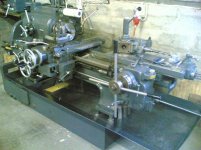zoeper
Cast Iron
- Joined
- Jul 8, 2010
- Location
- South Africa, Cape Town
Hi Guys,
I have a fairly old Capstan lathe by Alfred Herbert, No 4 Senior.
This machine is very solid and the ways are all in exceptionally good shape. The machine does not have a normal tailstock, but is fitted with a turret slide.
I want to use the turret lathe mainly for cutting chambers, threading and crowning work.
How would you rate this machine's suitability for these tasks?
I also have a small 10" swing lathe with 25" between centers for making small parts.
Thank you
P
I have a fairly old Capstan lathe by Alfred Herbert, No 4 Senior.
This machine is very solid and the ways are all in exceptionally good shape. The machine does not have a normal tailstock, but is fitted with a turret slide.
I want to use the turret lathe mainly for cutting chambers, threading and crowning work.
How would you rate this machine's suitability for these tasks?
I also have a small 10" swing lathe with 25" between centers for making small parts.
Thank you
P



